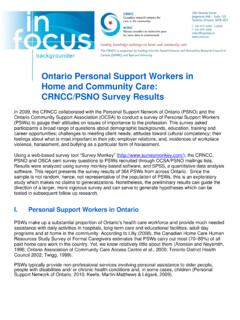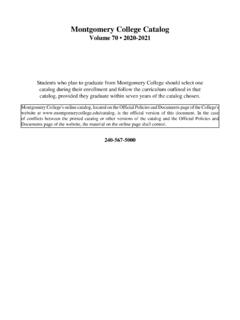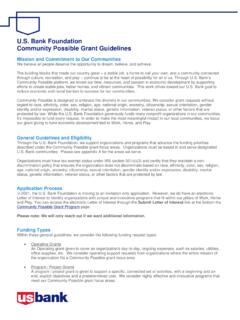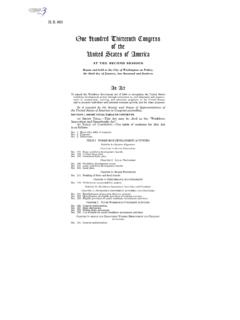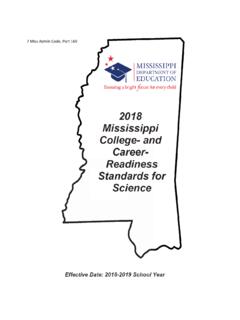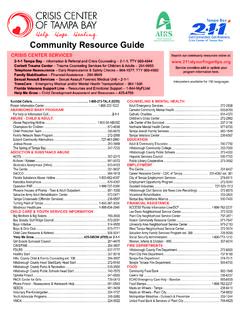Transcription of Noncredit Enrollment in Workforce Education
1 Michelle Van Noy, James Jacobs, Suzanne Korey, Thomas Bailey, and Katherine L. HughesNoncredit Enrollment in Workforce Education :State Policies and community college Practices American Association of community Colleges Washington, DC This report may be cited or reproduced in whole or in part, without permission, with the proviso that the original source is cited as follows:Van Noy, M., Jacobs, J., Korey, S., Bailey, T., & Hughes, K. L. (2008). Noncredit Enrollment in Workforce Education : State policies and community college practices [Report]. Washington, DC: American Association of community Colleges and community college Research Center. Available from the AACC Web site: for the study on which this report is based was generously provided by the Alfred P.
2 Sloan Foundation. The authors would like to thank the many policymakers and administrators from across the country who graciously shared information and insights with the study researchers. Thanks also to the study s advisory board members Jon Alexiou, Carol Brown, Andrew Meyer, Nan Poppe, Roberta Teahen, and Larry Warford for their guidance throughout; to Catherine Oleksiw from the Academy for Educational Development for her collegiality while conducting related research; to Gretchen Koball for her assistance in conducting interviews; to Michael Rudibaugh for assistance with the maps; and to Monica Mann, Wendy Schwartz, and Doug Slater for their editorial feedback.
3 Finally, we would like to thank the National Council for Workforce Education and the National Council for Continuing Education and Training for their assistance and support of this project. Any errors or omissions are strictly the responsibility of the the AuthorsMichelle Van Noy is a senior research assistant at the community college Research Jacobs is the associate director for community college operations at the community college Research Center and the president of Macomb community college in Korey is the director of Workforce Education in the Office of Career and Technical Education at the City college of San Bailey is the director of the community college Research Center, National Center for Postsecondary Research, and Institute on Education and the Economy.
4 He is also the George and Abby O Neill Professor of Economics and Education at Columbia University Teachers L. Hughes is the assistant director for work and Education reform research at the community college Research Center and Institute on Education and the Contact InformationMichelle Van NoyCommunity college Research CenterTeachers college , Columbia University525 West 120th Street, Box 174 New York, NY 10027 Tel: 212/678-3677E-mail: CCRC Web site: 2008 American Association of community Colleges and community college Research Centerii American Association of community CollegesContentsExecutive Summary ..2 Introduction ..4 Noncredit Program Roles.
5 4 Noncredit Program Structure ..5 Noncredit Program Outcomes ..5 Organization of the Report ..6 Methodology ..6 Research Questions and Data Sources ..6 Analytic Approach ..7 Definition of Terms ..8 Noncredit Program Roles ..9 Individuals Workforce Development and Access ..9 Workforce Preparation for Employers ..15 Revenue Generation for Colleges ..17 Implications of Noncredit Workforce Education s Roles ..19 Noncredit Program Structure ..19 Types of community college Organizational Approaches ..19 Areas of Organizational Change ..22 Implications of college -Level Organization ..25 Noncredit Program Outcomes ..25 Recorded Outcomes ..25 Data and Reporting.
6 30 Implications of Noncredit Workforce Education Outcomes ..33 Recommendations ..34 References ..36 Appendix A: Departments and Additional Resources Consulted ..39 Appendix B: State Policies on Noncredit Workforce Education ..41 Appendix C: State Policies on Noncredit Workforce Education in Case Study college States ..43 Appendix D: Description of Case Study Colleges ..44 Appendix E: Summary of Findings and Recommendations ..58 Noncredit Enrollment in Workforce Education 1 Executive SummaryIntroductionPostsecondary Noncredit Education has become increasingly common; many community colleges now enroll more Noncredit than credit students. Much of the growth has oc-curred in Workforce instruction and contract training.
7 These programs are noted for their important role in meeting shift-ing Workforce demands and providing skills in a way that is flexible and responsive to employer needs. Growth in this sector raises fundamental questions about whether colleges are keeping pace with need, using resources efficiently, and providing access to all students. The answers may challenge current state policies and college CCRC study, funded by the Sloan Foundation and conducted in collaboration with the National Council for Workforce Education and the National Council for Continuing Education and Training, focused on Noncredit Workforce instruction and contract training in community colleges.
8 Specifically, it examined (1) the extent to which Noncredit Workforce Education and state policies play a role in Workforce development, provide disadvantaged groups with access to higher Education , and generate revenue for colleges; (2) how colleges organize their Noncredit Workforce programs to balance the tradeoffs between the desired flexibility of Noncredit Education and the integration of credit and Noncredit programs; and (3) the extent to which Noncredit Workforce Education provides recorded outcomes for students, such as transcripts or industry certifications, and the extent to which outcome data are key sources of information were used.
9 First, we reviewed Noncredit Workforce Education policies on funding and regulation in all 50 states by interviewing people in state departments with oversight for community colleges or Workforce development. Second, we obtained case studies of 20 community colleges in 10 states by interviewing key administrative staff. The colleges selected reflect innovative practices in Noncredit Workforce Education , as well as demographic Program RolesAs a local Workforce development resource, community colleges serve many people seeking Education for a variety of reasons and a wide range of industries needing employees at different skill levels. Noncredit students in the case study colleges have diverse educational backgrounds and tend to be older and interested in gaining skills.
10 To bring students interested in pursuing a degree into credit programs, the colleges use a variety of features, such as recruiting Noncredit students to credit programs and developing linkages between Noncredit and credit programs. To support Noncredit Enrollment , more than half of the states provide general funds for community college Noncredit Workforce Education , which may provide an important indication of the state s vision for Noncredit Education . More than half the states have guidelines for defining Noncredit Workforce addition to meeting students needs, the colleges seek to meet specific employer needs at the state and local levels. Some have developed flexible ways to offer courses in response to employer demand.










